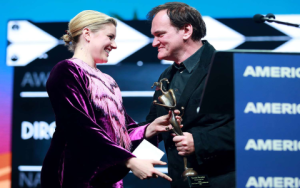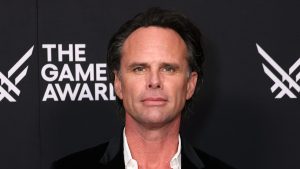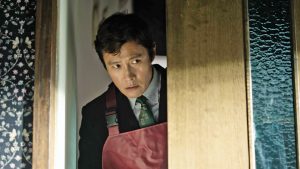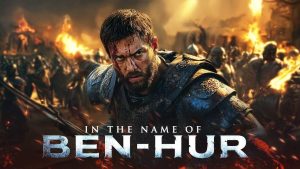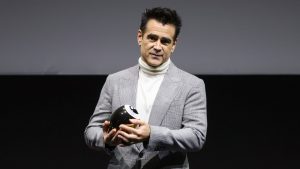
Tribal warfare is in the air in Vincent Grashaw‘s crime drama Keep Quiet. Lou Diamond Phillips stars as Teddy, a weathered tribal cop who, with his new trainee, Sandra (Dana Namerode), must find ruthless fugitive Richie, played by Elisha Pratt (Killers of the Flower Moon, True Detective). After all, Richie’s return to their rural Indigenous reservation “has exposed its darkest secrets and could ignite a violent gang war.”
That is the menacing set-up for Keep Quiet, which world premieres in an out-of-competition spot at the 78th edition of the Locarno Film Festival on Friday, a year after the director debuted boxing drama Bang Bang at the Swiss fest.
Nick Stahl, Irene Bedard, Lane Factor and Kimberly Guerrero round out the ensemble cast of the film, which is based on a screenplay by Zach Montague. Visit Films is handling international sales on the project.
Filmed on the Cheyenne and Arapaho Tribe reservations and the surrounding small towns in
Oklahoma, Keep Quiet was produced by Ran Namerode and Angelia Adzic of Randomix Productions, Cole Payne of Traverse Media, and Grashaw. Phillips, Marcus Red Thunder, and Richard Janes served as executive producers.
Before the movie’s Locarno premiere, THR talked to Phillips, Pratt and Grashaw about Keep Quiet, making an entertaining movie that also dives into serious issues and has depth, and Indigenous representation.
“The main goal was to tell this human story but also make a commercial movie, something that is entertaining, suspenseful and taps into a mass audience,” says Grashaw. “It deals with important themes, but we also focused on it being entertaining.”
The film may play out in an Indigenous setting, but the themes it explores, including family, community bonds, loss and grief, are global. “This story is incredibly universal,” says Phillips. “Yes, it deals with Native American gangs. But it could just as well be the Latino gang experience, which I dealt with in Stand and Deliver and in Filly Brown, or the experience of the Asian-American or the African-American community.”
Grashaw was excited to get Phillips on board as “the anchor” of the movie, the director says. “The script just jumped off the page,” recalls Phillips. “That role was just something that I saw myself in from page one, and I knew exactly who this guy was. And then I watched Bang Bang, which Vincent had done with Tim Blake Nelson, and I went, ‘This is an incredibly accomplished director.’ This is a guy with vision. This is a guy who goes in with the gloves off!”
Similarly, Pratt felt great about his audition experience. “Vince would give me notes, and I would take the notes and kind of do what he was asking me to do,” he recalls. “It was just one of those great experiences where I felt like I could let loose in the room and just leave it all in there.”
Grashaw loved Pratt’s audition. “I was blown away,” he shares. “During his read, I was scared of him. I was like, ‘Oh my God, he’s the guy!’ There was no question.”
The cast chemistry also felt right. Phillips compares the dynamic between Namerode and himself with that of Denzel Washington and Ethan Hawke in Training Day or Sean Penn and Robert Duvall in Colors. “It has that grittiness and that authenticity,” he tells THR.
And their two tribal police detectives are ethnic mixes rather than Indigenous people. “With Vincent giving us these roles, we’re representative of who we are,” says Phillips. “I’m a massive mix. It’s a recognition of the fact that America is such a melting pot. You don’t have to be one thing or another to represent these particular characters.”

Courtesy of Randomix Productions
Phillips plays a character who married into the reservation. “Interestingly, that gives him a perspective of almost an eternal outsider, which makes him more nuanced and more interesting,” explains the actor. “It was very, very important for this film to capture the heart of it and to tell the story as ambassadors for communities. For a very long time, I’ve represented the Latino community in many, many different communities under that umbrella, and First Nations. It’s always been important to me that we bring pride to the community in doing so.”
Representing life in Indigenous communities accurately was a particularly important focus for the creative team, helped by actor and technical advisor Marcus Red Thunder. Phillips knew him from his years as a technical advisor on Longmire and knew he could help the production approach life in a tribal community “with a great deal of honesty, authenticity and respect.” The advisor also served as a liaison to the Cheyenne and Arapaho nations and the Cherokee nations.
“I feel that the film really represents what you see on reservations or small native communities,” Pratt tells THR. “I grew up in a Native American community, and I know what it is like to lose people while those people are still young, to deal with grief and trauma. I’ve lived this life. You see cops that might be tribal police, but they’re not tribal — just like in the film. You see people, I guess you could call them outsiders, who marry into the community, and they become part of the community, just like Teddy in the film. So, it all felt very accurate and true, because I’ve seen and experienced this.”
Based on Marcus Red Thunder’s advice, the movie does not mention any specific area or tribe, helping to make the story more universal. For example, cross-jurisdictional problems between sheriff departments and tribal police depicted in the movie go well beyond one territory.
Indigenous representation also extended to the crew, including production designer Rebekah Bell and others. “We had as much as we could in shooting in Oklahoma,” Grashaw told THR.
Marcus Red Thunder can even be seen in a scene of the film. “When we went and met the Cheyenne and Arapaho tribes, he introduced us, and they did a blessing for us,” Grashaw recalls. “These are some of the nicest people you’ll ever meet, in terms of their upbeat spirit. They met up with Lou, and they were giving him gifts. It was just a really beautiful moment.”
The film team also got to meet a herd of around 600 bison thanks to the Indigenous hosts. “When they showed us that, I remember turning to the producer and saying, ‘We got to have a sequence in the film with this,’ and they let us write it in and shoot it,” the director says. “And that was Lou’s first day on set!”
Representing Indigenous life on screen was, of course, also driven by Indigenous talent in the movie. Pratt, for example, could bring his own life experiences to the set. “Growing up in native communities and reservations, you’re just able to see the things that people go through. And you know that despite the hardships, people want to do good,” Pratt tells THR. “Yeah, there are people who do bad things, but in their mind, they think they’re doing the right thing. Drawing upon this experience helped me bring Richie to life.”

Courtesy of Randomix Productions
You may find yourself rooting for Phillips’ Teddy, but he is also far from perfect. “One of the really attractive things about Teddy was that he is a flawed human being and has his own demons,” Phillips tells THR. “He’s got his own darkness. Yet, he is trying to do the right thing, not only for his family, but for the community that he has taken close to his heart.”
Concludes the star: “Let’s be honest. Sometimes he’s not likable. Sometimes he’s an asshole. He’s definitely kind of like a drill sergeant who is a proponent of tough love. But I think the most important thing for me was that his character rang true.”
Phillips and Pratt both lauded the film’s script and Grashaw’s work as a director. “That script was so solid,” Phillips emphasized. “Not a whole lot needed to be embellished. Of course, things would come up in the moment, and we’d roll with them. But as the director, Vincent was just wonderful. Some directors will talk you to death. Or they’ll overanalyze something. But it’s not about talking about it, it’s about doing it. Vincent was meticulous at the script stage. But if you cast it right, people will come in and just live it in front of the camera. And Vincent is wise enough to just capture that and tweak it as we go along.”
Does the Keep Quiet creative team have any regrets? “I wish I could have worked more with Lou,” Pratt tells THR. “I think I got one day with Lou, and I was like, ‘man, if I only had some more time with him,’ because I love watching him. I was actually eyeballing him the whole time, just watching what he’s doing, just studying him. Man, this guy’s got such charisma that just really motivates me!”
After Locarno, Keep Quiet will continue its festival circuit run at Oldenburg. “I’m so excited about all that, and I’m looking forward to the time when a stateside audience can see it as well,” Phillips tells THR. “You put your heart and soul into something like this, and there’s not a lot of money, and there’s not a lot of time. But as hard as it is, and as difficult as it is, you commit to a project like this and make something that you’re proud of. It’s a film that deserves to be seen by a very, very wide audience.”
#Lou #Diamond #Phillips #Elisha #Pratt #Interview #Film #Quiet

